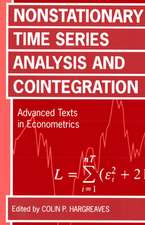Co-trending: A Statistical System Analysis of Economic Trends
Autor M. Hatanaka, H. Yamadaen Limba Engleză Paperback – 23 aug 2014
Preț: 378.54 lei
Nou
Puncte Express: 568
Preț estimativ în valută:
72.44€ • 77.46$ • 60.39£
72.44€ • 77.46$ • 60.39£
Carte tipărită la comandă
Livrare economică 18 aprilie-02 mai
Preluare comenzi: 021 569.72.76
Specificații
ISBN-13: 9784431659143
ISBN-10: 4431659145
Pagini: 128
Ilustrații: X, 115 p.
Dimensiuni: 155 x 235 x 7 mm
Greutate: 0.19 kg
Ediția:Softcover reprint of the original 1st ed. 2003
Editura: Springer
Colecția Springer
Locul publicării:Tokyo, Japan
ISBN-10: 4431659145
Pagini: 128
Ilustrații: X, 115 p.
Dimensiuni: 155 x 235 x 7 mm
Greutate: 0.19 kg
Ediția:Softcover reprint of the original 1st ed. 2003
Editura: Springer
Colecția Springer
Locul publicării:Tokyo, Japan
Public țintă
ResearchCuprins
1 Introduction.- 1.1 Motivation and Results of the Research.- 1.2 Review of the Literature.- 1.3 Exploration of Different Approaches.- 1.4 Notations.- 2 Co-trending.- 2.1 Co-trending in the Non-parametric Approach.- 2.2 Co-trending in the Parametric Approach.- 2.3 Trend Functions.- 2.4 Co-trending and Co-breaking.- 2.5 A Survey on the Direct and the Indirect Modelling of Trend.- 3 Statistics from the Data Covariance Matrix.- 3.1 Three-way Decomposition of the n-Dimensional Space.- 3.2 Group ?.- 3.3 Group 2.- 3.4 Group 1.- 3.5 An Approximation of P(X).- 3.6 Plan for the Rest of the Book.- 4 Principal Components.- 4.1 Group ?, i = 1, ...., n - r.- 4.2 Group 2, i = n - r + 1, ...., n - r1, r2 > 0.- 4.3 Group 1, i = n - r1 + 1, ...., n, r1 > 0.- 5 Unit Root Tests.- 5.1 Univariate Unit Root Test.- 5.2 Group ?: The Case Where B???,i is not a Cointegration Vector.- 5.3 Group ?: The Case Where B???,i is a Cointegration Vector.- 5.4 Group 2: The Case Where r2 = 1, and Group 1.- 5.5 Multivariate Unit Root Test.- 5.6 Group 2: The Case Where r2 > 2.- 5.7 Mistaken Constituents of Groups.- 5.8 Supplement on the Martingale Covariance.- 6 Trend Tests.- 6.1 Discrimination Between Group 1 and Group ? with B???,i as a Cointegration Vector.- 6.2 Failure of the Standard Trend Tests in Discriminating Groups ? and 2.- 6.3 Test Statistic and Limit Distribution for the Discrimination Between Group 2 and Group ? with B???,i not in the Cointegrating Space.- 6.4 Reduced Rank Regression of X on S H.- 6.5 A Finite Sample Analysis of the Reduced Rank Regression.- 6.6 Asymptotic Analyses of the Reduced Rank Regression.- 6.7 Data-Dependent Critical Value.- 6.8 Mistaken Constituents of the Groups ? and 2.- 7 Sequential Decision Rule.- 7.1 Grouping Method.- 7.2Sequential Decision Rule.- 7.3 Tests of a Grouping Method.- 7.4 Justification of the Sequential Decision Rule.- 7.5 Supplement.- 8 Simulation Studies.- 8.1 DGP.- 8.2 Details of the Trend Test for I(0).- 8.3 A Table of Asymptotic Probabilities.- 8.4 Results of Simulation Studies.- 8.5 Empirical Example.- A Mathematical Proofs.- A.l Mathematical Proofs of Propositions and Lemmas in Chapter 2.- A.2 Mathematical Proofs of Propositions and Lemmas in Chapter 3.- A.3 Mathematical Proofs of Propositions and Lemmas in Chapter 4.- A.4 Mathematical Proofs of Propositions and Lemmas in Chapter 5.- A.5 Mathematical Proofs of Propositions and Lemmas in Chapter 6.- B.3 Estimation of the VAR, (B.3).- C Determination of the Co-breaking Rank.- C.1 The Number of Common Breaks.- C.2 Detrended Covariance Matrix.- C.3 UURT.- C.4 MURT.- C.5 TRT.- Notes.- References.
Caracteristici
A research monograph on the time series econometric methods that are applied to macro-economic studies It builds upon the results on cointegrated VAR by Professors Granger and Johansen, but turns its focus from the stochastic integrated components to the relations among the deterministic trends of different variables It provides methods to investigate the economic growth in the circumstances where the growth rates are subjected to structural changes Though the authors have been motivated by the Japanese economic growth, the book is hoped to find applicability to other countries as well














